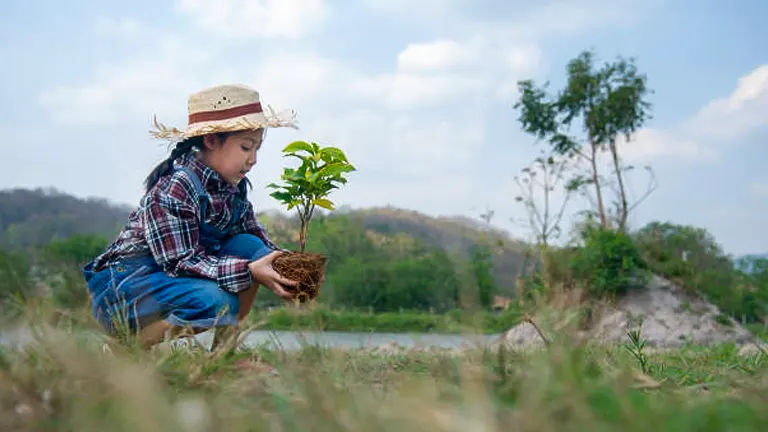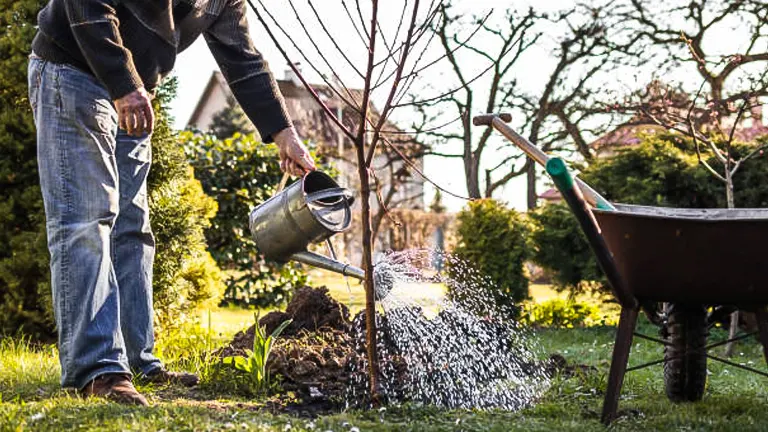When is the Ideal Time to Plant Trees? A Comprehensive Seasonal Guide
- April 16, 2024
- 0 comment
Discover the best seasons to plant trees for health and growth. Learn timing for deciduous, evergreen, and fruit trees in our guide. Understanding when to plant trees is crucial for their survival and growth. This comprehensive seasonal guide is designed to help you determine the optimal times to plant various types of trees, from deciduous to evergreen to fruit-bearing species.

Given the significant role that climate zones and tree growth cycles play, the right timing can enhance your garden’s vitality and aesthetics. Whether you are an experienced gardener or a novice looking to beautify your outdoor space, this guide provides essential insights and practical tips to ensure your trees thrive. Let’s explore how to give your trees the best start possible.
Table of Contents
- Understanding the Basics of the Ideal Time to Plant Trees
- Best Planting Times by Tree Type
- Seasonal Planting Guide
- Site Preparation and Planting Techniques
- Aftercare and Long-Term Maintenance
- Conclusion
- FAQs
Understanding the Basics of the Ideal Time to Plant Trees

Timing is a pivotal factor in tree planting, influencing the success rate significantly due to environmental interactions and biological needs:
- Root Establishment: Trees planted at the optimal time benefit from favorable weather conditions, allowing them to establish strong root systems. Proper timing mitigates stress factors like extreme temperatures, which can disrupt the delicate process of root development and nutrient uptake.
- Growth Cycles: Trees have distinct growth cycles, including dormant and active growth phases typically aligned with the seasons. Planting during the dormancy period (usually in winter) minimizes energy expenditure on growth, which can instead be directed towards developing a robust root network. When active growth resumes in spring, a well-established root system supports healthier and more vigorous development.
Factors Influencing Planting Time
Climatic Zones:
The USDA Plant Hardiness Zone Map divides North America into 13 zones based on average annual minimum winter temperatures. This zoning is crucial for determining the safest planting times to avoid frost damage and ensure survival.
- Zone Variability: Each zone has specific temperature ranges that dictate not only the best planting times but also which tree species are most likely to thrive.
Tree Dormancy and Active Growth Phases:
Understanding a tree’s natural cycles is key to timing your planting:
- Dormancy Phase: Occurs during the colder months when trees conserve energy. Planting at this time, especially just before the active growth phase begins, allows trees to establish without the stress of supporting leaves and branches.
- Active Growth Phase: Starts in the spring with rising temperatures. Trees use the energy stored from dormancy to spring into vigorous growth.
Optimal Planting Times by USDA Zone
| USDA Zone | Recommended Planting Time | Tree Examples |
|---|---|---|
| 1-3 | Late Spring to Early Summer | Spruce, Douglas Fir |
| 4-6 | Early Spring or Late Fall | Maple, Oak, Elm |
| 7-9 | Fall to Early Winter | Dogwood, Magnolia |
| 10-13 | Late Winter to Early Spring | Citrus, Palm |
Note: The table simplifies the planting times for general categories of trees commonly found in each climatic zone.
Scientific Analysis and Considerations
- Temperature and Growth: Research shows that soil temperatures of 55°F (about 12.8°C) are ideal for root growth in many common tree species. Planting should occur when soil temperatures are approaching this range, which varies by geographic location and local weather patterns.
- Moisture and Seasonality: Adequate soil moisture is critical. The best planting times are often after the start of the rainy season in your area. For example, in zones 7-9, fall planting is optimal as it coincides with increased rainfall and cooler temperatures that support root growth without the excessive water loss seen in summer.
- Long-term Climate Trends: Considering long-term climatic conditions and anomalies, such as El Niño or La Niña years, can also influence the best planting times. These patterns can shift the typical weather conditions, affecting the best planting seasons by altering temperatures and precipitation levels.
Enhanced Planting Strategy
- Chilling Hours: Many trees require a specific number of chilling hours (hours below 45°F or 7.2°C) to break dormancy properly and begin growth cycles. Monitoring winter temperatures can help in planning the ideal planting schedule to optimize this natural process.
- Photoperiod Sensitivity: The length of day and night also affects tree growth cycles. Planting should ideally be adjusted based on the photoperiod, with consideration for latitude and specific species requirements, to align with natural growth initiators.
Best Planting Times by Tree Type

Deciduous Trees: Deciduous trees, which lose their leaves annually, benefit significantly from being planted during the fall, although early spring is also an effective time, especially in regions with harsh winters.
- Fall Planting:
- Timing: Ideal months for planting are from late September to mid-November.
- Advantages: During fall, the soil is still warm, which promotes root growth, but the cool air minimizes the energy the tree spends on leaf development—allowing it to focus on establishing a robust root system. This season also typically has more rainfall, reducing the need for manual watering.
- Physiological Impact: Trees undergo less physiological stress since they are not actively growing above ground and can direct more energy towards root development.
- Spring Planting:
- Timing: As soon as the ground thaws and is workable, typically in early spring.
- Advantages: Spring planting must be timed after the last frost to avoid frost damage to new roots. This timing gives the tree a full growing season to mature before the challenges of winter set in.
- Considerations: Trees planted in spring need careful monitoring and regular watering throughout the summer until they establish.
Evergreen Trees: Evergreens retain their leaves throughout the year and are best planted in the early fall.
- Fall Planting:
- Timing: Early to mid-autumn is optimal.
- Advantages: Cooler temperatures reduce transpirational loss (water loss from leaves), and increased rainfall can help establish new plantings without the supplemental watering required in warmer months.
Fruit Trees: The best times to plant fruit trees vary depending on the species and local climate conditions.
- Temperate Fruit Trees:
- Varieties: Includes apples, pears, and plums.
- Ideal Planting Time: Early spring.
- Why: Planting in early spring helps avoid winter cold stress and allows for significant root development before the onset of summer heat, which is crucial for young fruit trees to thrive.
- Tropical Fruit Trees:
- Varieties: Includes citrus and mangoes.
- Ideal Planting Time: Late spring to early summer.
- Why: Ensures the soil temperature is warm enough to promote root growth without the risk of frost damage.
Ornamental Trees: Ornamental trees, often planted for their aesthetic appeal, do well when planted in early spring.
- Spring Planting:
- Considerations: Early planting is crucial as these trees need to establish themselves before the summer heat, which is particularly important for species expected to flower in the same year.
Optimal Planting Times by Tree Type
| Tree Type | Best Planting Time | Key Considerations |
|---|---|---|
| Deciduous | Fall (Sep-Nov) | Focus on root development, less water needed |
| Evergreen | Early Fall | Cooler temps, adequate rainfall |
| Temperate Fruit | Early Spring | Avoid winter stress, prepare for summer |
| Tropical Fruit | Late Spring/Summer | Warm soil, no frost risk |
| Ornamental | Early Spring | Establish before summer heat |
Seasonal Planting Guide
Spring Planting

Planting trees in the spring takes advantage of the season’s mild temperatures and ample rainfall, providing ideal conditions for young trees to establish robust roots. This period is crucial for a wide variety of tree species, from towering deciduous to vibrant ornamentals.
Advantages of Spring Planting:
Spring is beneficial for new plantings due to its moderate weather, which helps young trees acclimate without the stress of frost or extreme heat. The season’s increasing daylight and warmth promote healthy photosynthesis, while frequent showers support deep root development, reducing the need for manual watering.
Recommended Trees for Spring Planting:
- Deciduous Trees: Oaks, maples, and elms thrive when planted during this season as they prepare for full growth in the summer, building a strong foundation before the onset of winter.
- Fruit Trees: Apple, pear, and plum trees especially benefit from the spring planting. They require a growing season ahead to mature adequately before winter.
- Ornamental Trees: Planting trees like dogwoods and magnolias in spring allows them to settle in and bloom beautifully in the subsequent spring.
Key Planting Tips for Spring:
For optimal growth, ensure regular, deep watering to help the trees establish their roots. Applying a layer of mulch around the base can help retain soil moisture, suppress weeds, and regulate soil temperature. In windy areas, consider staking young trees to provide stability and prevent root damage.
Summer Planting

Although summer might not be the ideal time to plant most trees due to the intense heat and potential for drought, certain species adapted to high temperatures can still be planted during this season.
Challenges of Summer Planting:
The primary challenges during summer include high temperatures that can stress young saplings and irregular rainfall patterns, which might not provide sufficient water for new trees. These conditions make it crucial to select the right species and provide adequate care.
Suitable Trees for Summer Planting:
- Tropical Fruit Trees: Species such as citrus and mango are well-suited for summer planting. They thrive in steady heat, provided they receive consistent and ample watering.
- Certain Evergreens: Varieties like pines and cedars can also be planted during this time, as long as they are watered thoroughly and mulched to retain soil moisture.
Care Tips for Summer Planting:
To successfully plant trees in summer, water them deeply and regularly to prevent drought stress. Mulching is also critical to keep the root environment cool and moist. Providing some shade can also be beneficial, especially in the hottest parts of the day.
Fall Planting

Fall is arguably the best time to plant most types of trees. The cooler temperatures allow the trees to establish roots in the new location without the stress of a blazing summer sun, and the beginning of the rainy season means less watering is required.
Benefits of Fall Planting:
Planting trees in the fall leverages the mild weather, which is conducive to root development. The soil is still warm, which promotes root growth, but the cool air reduces the likelihood of top-growth before the winter, allowing the tree to focus on establishing a strong root system.
Ideal Trees for Fall Planting:
- Deciduous Trees: Many deciduous trees do well when planted in the fall because they can establish roots during the winter dormancy period and burst into growth in the spring.
- Evergreens: Early fall is perfect for evergreens as it gives them enough time to settle before the winter.
Planting Strategy for Fall:
When planting trees in the fall, it is essential to water them thoroughly until the ground freezes, which helps them establish. Mulching with organic material will also protect the roots from freezing temperatures and provide nutrients for the spring growth.
Winter Planting

Winter planting is not typically recommended due to the hard, frozen soil and potentially harsh conditions; however, in milder climates where the ground remains workable, certain trees can still be successfully planted.
Challenges of Winter Planting:
- Frozen Ground: Can make planting difficult and can stress the trees.
- Cold Temperatures: Young saplings might be vulnerable to frost damage which can retard their growth or even kill them.
Suitable Trees for Winter Planting:
- Hardy Deciduous Trees: Some species like sugar maples and ash trees, which are dormant in winter and less likely to suffer transplant shock.
- Weather-Resistant Evergreens: Such as hollies and some pines that can cope with colder temperatures.
Care Tips for Winter Planting:
If planting during winter is the only option, ensure the ground is not frozen at the time of planting and mulch heavily after planting to insulate the root area. Regular winter watering might be necessary during dry spells to keep the root ball from drying out.
Site Preparation and Planting Techniques

Proper site preparation and the correct planting technique are crucial for ensuring the successful establishment and growth of your trees.
Site Preparation
The first step in planting a tree involves preparing the site:
- Choosing the Right Location:
- Sunlight: Ensure the location receives at least six hours of direct sunlight daily, as most trees require full sun to thrive.
- Soil Drainage: Good drainage is essential to prevent root diseases. Perform a simple test by digging a hole (about 10 inches deep) and filling it with water. The water should drain within 12 hours to ensure the soil is not too compacted or clayey.
- Space to Grow: Allow enough space for the tree’s canopy and root system to expand. This helps minimize fungal issues and physical damage as the tree matures.
- Soil Preparation:
- Loosen the Soil: Before planting, loosen the soil to a depth of 12-18 inches to facilitate easy root growth.
- Amend the Soil: Depending on the soil type (clayey or sandy), it may be beneficial to amend it with organic matter such as compost or aged manure. This will improve soil fertility and enhance its water-holding capacity.
Planting Techniques
When planting a tree, proper technique will help ensure that it establishes quickly and thrives:
- Digging the Hole:
- The hole should be twice as wide as the root ball of the tree to allow for extensive root growth.
- The depth of the hole should be a few inches less than the height of the root ball to prevent the tree from settling too deeply, which can cause stem rot.
- Placing the Tree:
- Remove the tree from its container and inspect the root ball. Loosen any circling roots to encourage outward growth.
- Set the tree in the middle of the hole. The top of the root ball should be slightly above ground level to allow for natural settling.
- Backfilling the Hole:
- Fill the hole with the excavated soil. Gently tamp down the soil as you backfill to eliminate air pockets.
- Water thoroughly after backfilling to settle the soil around the roots and to hydrate the tree.
- Mulching:
- Apply a 2-3 inch layer of mulch around the base of the tree, extending out to the drip line (the outermost circumference of the tree’s canopy). Keep the mulch a few inches away from the trunk to prevent moisture buildup against the bark.
- Staking:
- If the tree is tall or in a windy area, staking may be necessary. Use stakes placed on opposite sides of the tree and attach them with wide, flexible tree straps. Avoid tying materials directly against the bark, as this can cause damage.
- Watering:
- Establish a regular watering schedule until the tree is well-established. The frequency and amount of water will depend on the species and your local climate conditions.
Aftercare and Long-Term Maintenance

Once trees are planted, proper aftercare is crucial to their survival and growth. This section covers essential practices that will help newly planted trees thrive, from the initial care after planting to long-term maintenance strategies.
Initial Care
Initial care is critical in the first few weeks after planting:
- Watering: Newly planted trees require consistent moisture to help establish their roots. Water deeply at the base of the tree immediately after planting, and continue to water every day for the first two weeks. Afterward, reduce watering to once a week, adjusting based on weather conditions and soil type.
- Mulching: Apply a 2-3 inch layer of organic mulch around the planting area but not directly against the tree trunk. Mulch helps retain soil moisture, prevents weed growth, and regulates soil temperature.
- Protection: Use tree guards or plastic wraps to protect the tree trunk from pests, mechanical damages, and harsh weather conditions. This is particularly important in areas with small wildlife, such as rabbits or rodents, that might chew on the bark.
Ongoing Care
As the tree matures, its needs will change but regular care is still necessary:
- Pruning: Begin pruning during the dormant season, typically in late winter before the spring growth starts. Pruning helps shape the tree, removes dead or diseased branches, and promotes healthy growth.
- Fertilizing: Apply a balanced fertilizer in early spring and potentially again in autumn, but avoid over-fertilizing which can lead to poor growth and weak health. Use fertilizers that are appropriate for the specific type of tree and its soil needs.
- Inspecting for Pests and Diseases: Regularly inspect the tree for signs of pests and diseases. Early detection is key to managing potential issues before they become severe. Use environmentally friendly pesticides or natural remedies where possible to treat any infestations or infections.
Seasonal Maintenance
Caring for trees also involves preparing them for different seasons:
- Spring: Inspect the tree for winter damage and prune accordingly. Fertilize to give the tree a nutrient boost for the growing season.
- Summer: Continue regular watering, especially during hot, dry spells. Mulch should be replenished to maintain moisture levels in the soil.
- Fall: Prepare trees for winter by applying a fresh layer of mulch and conducting a thorough health inspection. Prune if necessary.
- Winter: Ensure protection from snow and frost. Wrap the trunk if using guards and check stability to withstand winter storms.
Long-Term Health
Maintaining the health of trees over the long term will ensure they continue to provide beauty, shade, and environmental benefits:
- Soil Care: Periodically test the soil’s nutrient and pH levels to ensure it remains conducive to your tree’s health. Amend the soil as needed based on test results.
- Tree Replacement: If a tree becomes too diseased, consider replacing it to prevent issues from spreading to nearby plants and trees.
- Professional Assessments: For large or valuable trees, consider getting professional arborist assessments every few years to help diagnose and treat any major issues before they escalate.
Related Post
- How to Fertilize a Mango Tree Effectively: Tips and Tricks for Healthy Growth
- How to Fertilize Apple Trees: Essential Tips for a Bountiful Harvest
- How to Fertilize Lemon Trees: Secrets for Thriving Citrus
- How to Fertilize Avocado Tree: A Step-by-Step Guide for Lush Growth
Conclusion
The success of planting a tree extends beyond just choosing the right season. Proper site preparation, correct planting techniques, and diligent aftercare are all pivotal in ensuring the healthy growth and longevity of your trees. Regular watering, appropriate fertilization, timely pruning, and pest management play significant roles in a tree’s life cycle and overall health.
FAQs
- What is the best month to plant trees in the northern hemisphere?
In the northern hemisphere, the best months to plant trees are generally during the fall, from September to November. This timing allows the trees to establish roots in the cooler, moist soil before the ground freezes in winter. - Can I plant trees in early spring when frost is still possible?
Yes, early spring is a good time to plant trees even if frosts are still possible. Deciduous trees, in particular, can be planted as soon as the soil is workable. Frost generally does not harm the roots and the cool temperatures can encourage root growth before the heat of summer. - Is there a difference in planting times for fruit trees versus ornamental trees?
Yes, fruit trees often benefit from being planted in early spring because they need time to establish before bearing fruit, which generally requires more energy and stable conditions. Ornamental trees are more flexible but planting in early spring or during the fall when temperatures are mild is ideal. - What are the risks of planting trees in the summer?
Planting trees in the summer can be risky due to the high temperatures and dry conditions which can stress the plant and lead to poor root development or even death if not properly managed. If planting in summer is necessary, choose drought-resistant species and ensure adequate watering and mulching to retain soil moisture. - How do wet seasons affect tree planting times?
Wet seasons can actually be beneficial for planting trees as the increased moisture helps establish roots. However, extremely soggy soils can hinder root growth by limiting oxygen access. If planting during a wet season, ensure good drainage and consider raised beds if waterlogging is a concern. - Are there any trees that can be planted year-round?
In regions with mild climates, such as USDA zones 9-11, some trees can be planted year-round. However, even in these zones, avoiding the hottest and wettest months can help young trees establish more effectively. Typically, tropical species and some resilient natives like palms can be planted throughout the year if managed carefully. - What should I do if I plant a tree at the wrong time?
If you plant a tree during less than ideal conditions, ensure it has adequate water (but not waterlogged), protect it from extreme temperatures with mulch or tree wraps, and avoid fertilizing until it has shown signs of new growth. These steps can help mitigate the stress on the tree and support its recovery. - How do climate zones affect planting times?
Climate zones significantly impact planting times. Cooler zones (USDA zones 1-5) generally have shorter growing seasons, making late spring through early fall the window for planting to avoid frost damage. Warmer zones (6 and above) offer a longer planting season from early spring to late fall, as the ground doesn’t freeze and temperatures are milder.
Choosing the right season to plant trees is crucial for their success and longevity. Follow this seasonal guide to ensure your trees start strong and provide beauty and benefits for years to come.

Benjamin Brooks
Forestry AuthorGreetings! I'm Benjamin Brooks, and my journey over the past 15 years has revolved around the fascinating realms of content creation, expertise in snow clearing, and the intricate world of lumberjacking and landscaping. What began as a simple curiosity about the natural world and heavy machinery has evolved into a passionate profession where my love for crafting words intertwines seamlessly with my lumberjacking and garden skills.













Leave your comment